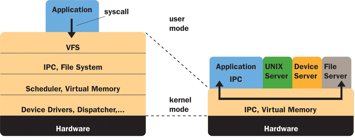Semi vendor taps hypervisor for open source Cortex-A9 phones
Oct 27, 2009 — by Eric Brown — from the LinuxDevices Archive — 2 viewsEmbedded virtualization vendor Open Kernel Labs (OK Labs) announced a partnership with wireless semiconductor firm ST-Ericsson. The joint project will combine OK Labs' OKL4 hypervisor and ST-Ericsson 3G multimedia chipsets on an ARM Cortex A9 multi-core platform running mobile open source operating systems including Linux, Android, and Symbian, says OK Labs.
The partnership should result in the first mobile virtualization chipset solution built on an ARM Cortex A9 platform, as well as the first to support SMP-capable open mobile operating systems, says OK Labs. Last December, OK Labs announced that OKL4 would support devices using ARM Cortex-A8 and Cortex-A9 MP Core multi-core CPUs. (See farther below for more on the Cortex-A9.)
ST-Ericsson's selection of the OKL4 "microvisor" was said to have followed a "rigorous evaluation of virtualization technologies" by ST-Ericsson. The partners are now working to build proofs-of-concept for a combined OK Labs/ST-Ericsson platform expected to be available in 2010.
In February, OK Labs rival VirtualLogix demonstrated its VLX virtualization stack running Android and a baseband RTOS on an ST-Ericsson reference design with a single ARM9 core.
OKL4 background
 Motorola Evoke QA4 (Click for details) |
The Linux-ready OKL4 version 3.0 is available in 300 million handsets and other mobile and embedded devices, including the Linux-based Motorola Evoke QA4 (pictured), says OK Labs. OKL4's microkernel OS runs almost everything in userspace, and includes a thin hardware abstraction layer that can support Linux, Windows Mobile, Windows CE, Symbian, and/or other guest OSes. It also includes a minimal POSIX-compliant execution environment, enabling multiple applications and device drivers to run in separate, isolated partitions.
OKL4 provides for decreased BOM (bill of materials), as well as the separation of GPL and proprietary software code as required by companies' intellectual property policies, claims OK Labs. The hypervisor provides sufficient CPU performance to support a Linux environment with a rich GUI in one virtualized compartment, while concurrently supporting real-time phone modem processing software in a separate compartment, says the company.

OKL4 3.0 architecture
In early May, OK Labs and Citrix announced they would deliver the "Citrix Receiver" virtualization client on OKL4. The partnership should let smartphones running Linux, Android, Symbian, and Windows Mobile display secure, virtualized Windows desktop images by the end of the year. The OKL4 version of Citrix Receiver will be targeted primarily at corporate IT departments and their users, who want to access secure corporate data on consumer smartphones, says OK Labs.
In June, OK Labs announced an Android version of OKL4. OK:Android is billed as an off-the-shelf, paravirtualized version of Android that enables Android to run as a guest OS in a secure "hypercell" alongside another phone OS.
In August, OK Labs announced the completion of a four-year research project with NICTA aimed at developing a highly secure, "100 percent bug-free" hypervisor for mobile phones. The "seL4" project will be applied to future versions of OKL4, says the company.
Cortex-A9 background
Announced in Oct. 2007, ARM's Cortex-A9 core is a multi-core capable variation on the earlier Cortex-A8 core, which is widely used in smartphones and other embedded devices. Like the Cortex-A8, it supports a dual-issue, superscalar pipeline that can execute multiple instructions simultaneously.
The faster Cortex-A9 provides clock speeds over 1GHz, and boasts performance of around 2,000 Dhrystone MIPS. The A9 also adds support for ARM's MPCore interconnect technology.
Originally envisioned as being manufactured on TSMC's 65nm process, the Cortex-A9 has been steadily shrinking, reaping potential savings in both board real estate and power consumption. Last February, for instance, ARM licensee Texas Instruments (TI) announced a 45nm, dual-core Cortex-A9 implementation, the OMAP4430 and OMAP4440, which it said would be sampling during the second half of 2009. Scheduled for volume production during the second half of 2010, the 45nm OMAP4 chips will include Powervr SGX540 graphics and be capable of 1080p video playback, says TI.
More recently, ARM announced new Cortex-A9 implementations, code-named "Osprey", that can achieve clock speeds above 2GHz. Designed for TSMC's 40nm process, the dual-core Osprey can run at 800MHz, consuming 0.5 Watts overall, or at 2GHz, consuming just 1.9 Watts, says ARM.
Earlier this month, ARM followed up with an announcement with Globalfoundries that the companies were launching a project to fabricate Cortex-A9 processors via a 28-nanometer HKMG (high-k metal gate) process.
Stated Teppo Hemia, head of 3G Multimedia Platforms Business Unit, ST-Ericsson, "Virtualization can bring higher flexibility to our mobile multimedia platforms and enable our customers to speed up time-to-market for mobile devices supporting a broad range of open OSes."
Stated Steve Subar, President and CEO, OK Labs, "On feature-rich silicon like ST-Ericsson 3G multimedia platforms, [OKL4] helps OEMs support multiple OSes; it gives ISVs more options for deploying applications; and it provides operators and enterprise IT with a reliable and secure foundation for rolling out value-added services and software."
Availability
The OK Labs/ST-Ericsson Cortex-A9-based mobile virtualization platform is expected to be available in 2010, says OK Labs. More information on OKL4 may be found here.
This article was originally published on LinuxDevices.com and has been donated to the open source community by QuinStreet Inc. Please visit LinuxToday.com for up-to-date news and articles about Linux and open source.